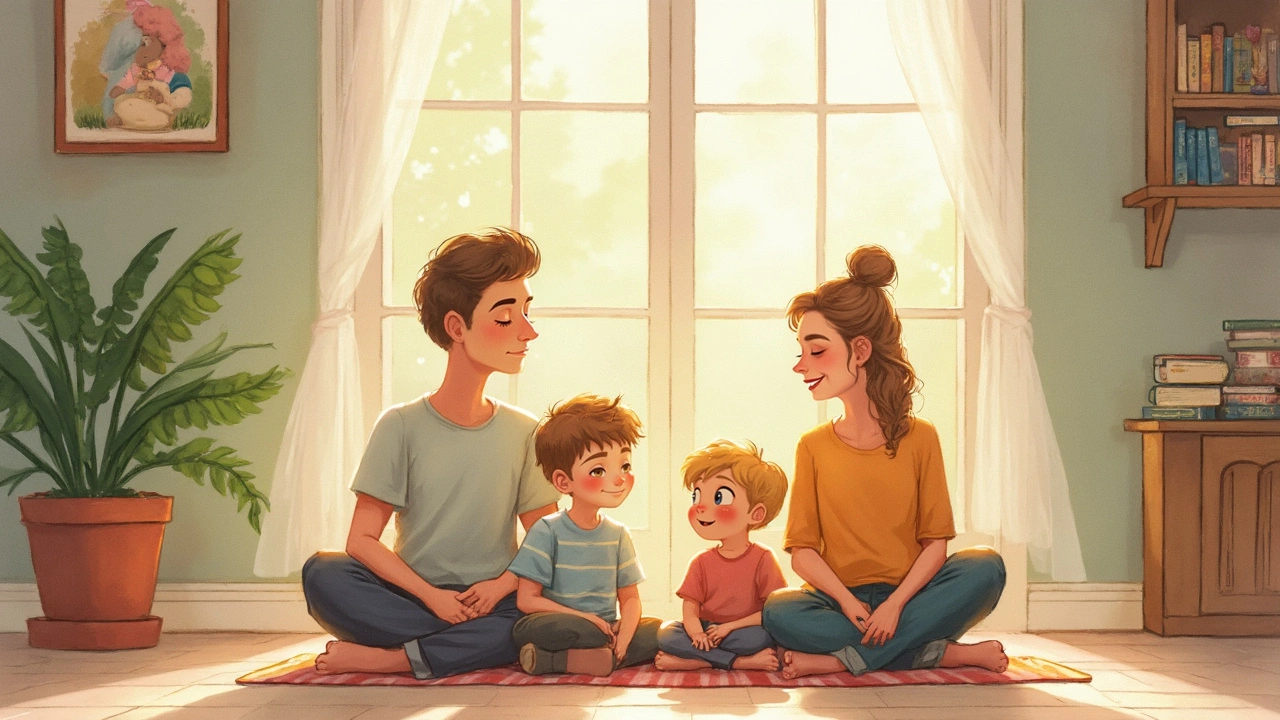Kids can get stressed out, just like adults. School pressures, busy schedules, and social issues don’t make things any easier. The cool part? Meditation doesn’t just work for grown-ups. Even young children can pick up basic techniques that help them calm down, pay attention, and feel more confident.
You don’t need incense or candles to get started. Sometimes, all it takes is guiding your kid to pay attention to their breathing for a minute or two. Set a timer, sit on the floor together, and close your eyes. Ask them to notice how the air feels in their nose or belly. That’s all it is—learning to be present. Try it before homework, bedtime, or when emotions are running high. These small moments can make a big difference in how kids handle tough stuff.
- Why Meditation Matters for Kids
- Making Mindfulness Fun and Simple
- Everyday Meditation: Quick Practices
- Real-Life Results: Stories from Families
Why Meditation Matters for Kids
You might wonder if meditation is really worth it for kids. Research out of Harvard even shows that mindful breathing changes the brain, helping kids focus more and stress less. With growing rates of anxiety seen in children, giving them tools for emotional control isn't just nice—it's becoming essential.
Kids aren’t born knowing how to handle racing thoughts or big feelings. When they get upset over homework or friends, meditation teaches them to notice what’s happening inside without freaking out. Studies have found children who practice regular meditation show better self-control, listen more easily, and even sleep deeper at night.
The trick? Keep it simple. Unlike adults, kids benefit most from bite-sized exercises. Five minutes of mindfulness can make a tough school morning run smoother. Teachers who introduce meditation in classrooms often report fewer conflicts and a calmer vibe. That’s because the practice trains young brains to slow down, which can help with everything from resisting the urge to blurt out answers to being kind on the playground.
- Short daily practices can lower stress hormones in the body.
- Kids who meditate might find it easier to pay attention during class or sports.
- Studies suggest better sleep patterns for kids who regularly practice mindfulness.
Parenting is tough enough. Adding meditation for kids to your routine isn’t just another chore—it’s an investment in emotional health that pays off right away and in the long run.
Making Mindfulness Fun and Simple
Getting kids into mindfulness doesn’t have to feel like another thing to add to your checklist. The trick is to keep it light, playful, and quick. Studies from UCLA’s Mindful Awareness Research Center show that kids as young as four can learn simple mindfulness skills when it’s made into a game. That means you don’t need long sessions—just a few minutes of focused fun each day.
Here are some easy ways families can weave mindfulness into daily life:
- Meditation for kids gets easier if you have a “calm jar” at home. Fill a jar with water, glitter, and a bit of glue. When shaken, kids can watch the glitter settle, which mimics what happens in our brains when we calm down.
- Turn breathing into play. Kids can lie down, place a favorite stuffed animal on their belly, and see if they can make it “ride the waves” by breathing in and out slowly.
- Try “listening walks.” Go outside and focus on all the different sounds—birds, cars, dogs barking. It teaches kids to tune in to the present moment.
- Use meditation apps made for kids. Programs like Smiling Mind or Headspace for Kids have tracks as short as one minute, which is just right for attention spans before bedtime or after a busy day.
Kids respond best when they’re not forced, so let them pick the activity or make it a family thing. You also don’t have to stick to the same routine every time. Mix it up and see what clicks best!
| Technique | Recommended Age | Session Length |
|---|---|---|
| Calm Jars | 3-8 | 2-5 minutes |
| Stuffed Animal Breathing | 3-7 | 1-3 minutes |
| Listening Walks | 5-10 | 5-10 minutes |
| Guided Meditations (Apps) | 4-10 | 1-5 minutes |
The goal isn't perfection. Even a single mindful minute can help kids handle frustration, focus in school, and sleep better at night. If it feels fun, kids come back for more.

Everyday Meditation: Quick Practices
Finding ways to squeeze in meditation for kids during daily life isn’t as tricky as you might think. The trick is to keep it short, simple, and a little bit fun. These mini-mindfulness breaks can happen in the car, before bed, or even in the middle of a hectic morning.
Here are a few proven ideas you can try with your child:
- Belly Breathing: Have your child lie on their back and put a small stuffed animal on their belly. Ask them to watch it rise and fall for a minute as they breathe slowly in and out. This helps slow the heart rate and chill out anxious nerves.
- Five Senses Game: When your kiddo feels overwhelmed, ask them to name one thing they see, hear, smell, taste, and touch. This moves their brain out of worry mode and into the present moment.
- Bubble Blowing: Give them a bottle of bubbles and encourage slow, controlled breaths to make the biggest bubble possible. It’s fun, and it naturally teaches focused, slow breathing.
- One-Minute Peace: Set a timer for 60 seconds and challenge your child to sit quietly and notice how their body feels, or listen for all the sounds around them. Even the shortest pause helps reset swirling thoughts.
Building these tiny routines into your day pays off. According to studies from Harvard and UCLA, a few mindful minutes can lead to better focus, stronger memory, and less stress for kids. You don’t have to wait for a meltdown either—using meditation for kids regularly boosts their ability to deal with whatever comes their way.
Real-Life Results: Stories from Families
If you’re curious about whether meditation for kids actually works, listen to some real stories of families who tried it at home. In 2023, a survey from NPR found that 12% of U.S. parents said their kids had practiced meditation and noticed clear changes in mood and focus. That’s not just background noise; parents are seeing actual benefits.
Take Sarah, a mom of two in Cleveland. She started using a five-minute breathing exercise with her seven-year-old before school each morning. After two weeks, her son’s teacher sent home a note saying he seemed less anxious and more patient. Sarah said, “It’s like hitting a reset button before the day even starts.”
Or look at the Johnsons from San Diego, who used meditation as a family during the pandemic. They saw fewer tantrums from their youngest, and their teenager reported sleeping better after guided meditations at night. “Everyone’s more chill, even me,” their dad joked.
Check out how some families use simple tricks so kids stick with it:
- Pairing meditation with story time — younger kids love visualizing their favorite animals or places
- Using apps like Headspace for Kids, which keeps things short and playful
- Letting kids lead sometimes — turning mindfulness into a game of "notice five things in the room"
If you like numbers, here’s a table showing what parents said changed most after starting regular meditation with their kids:
| Area of Change | % of Parents Noticing Improvement |
|---|---|
| Focus and Attention | 62% |
| Emotional Self-Control | 55% |
| Less Anxiety | 47% |
| Better Sleep | 38% |
It’s clear that meditation for kids is not some passing trend. With tiny tweaks to your routine, you could see these kinds of results at home—no special gear required.






